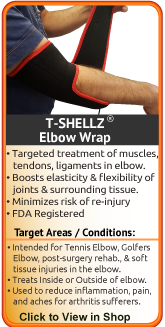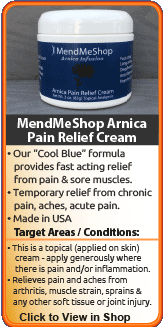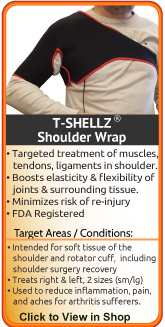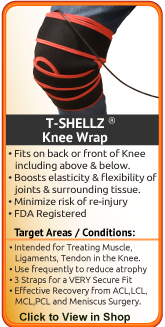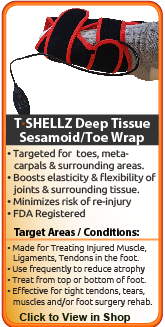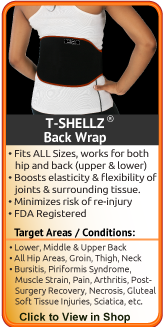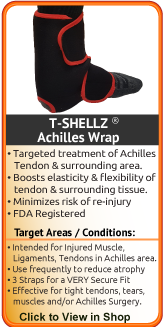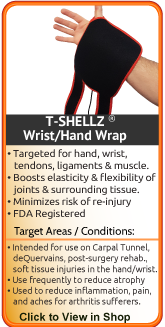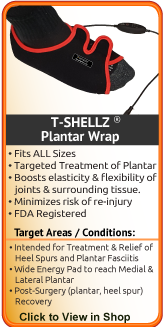Alternative Therapies and Exercise
Physio Appointments (PT)
PT is a beneficial way to help decrease pain, restore atrophied muscles, and improve shoulder strength and mobility. The type of PT and the duration will be dependent on your injury.
Once your pain starts to diminish, a physiotherapist will also set up an individualized shoulder strengthening and stretching exercise program for you to perform at home or in the gym. This will be based on your needs and abilities, and will help you return to performing your normal routines.
Individuals will often lift weights on their own, to try and build up their shoulder strength. However, in doing so, they can do more damage to their shoulder. It is extremely important to strengthen your muscles properly, as they may have weakened during the period of non-use. A trained therapist will help to ensure your rehabilitation process is effective. For best, long term results use TShellz Wrap treatments at home in conjunction with PT and an exercise program.
Minimize Irritation of the Bursa
The most important factor in healing bursitis is resting your shoulder. This can be difficult when you have to carry on with daily activities, but resting your shoulder whenever you can is recommended.
Keeping the pressure off the bursa (i.e. carrying a backpack or purse on the opposite shoulder) will help to relieve the symptoms of swelling, pain, and inflammation faster. Surgery may be required if your bursa irritation is a result of a bone formation problem, such as a hooked acromion causing impingement of the bursa. If your bursitis is caused by an infection (septic bursitis), the doctor will drain the bursa sac with a needle and prescribe antibiotics to treat the infection.
During your recovery, you may have to modify and/or eliminate any activities that cause pain or discomfort in your shoulder area until your pain and inflammation settle, and you gain more mobility and strength in your shoulder. Often you will notice a great improvement within 6 to 12 weeks; however it can take months to return to normal. The more diligent you are with your rehabilitation, the faster you will see successful results.
Shoulder Bursitis Home Remedies
What You Can Do!
Conservative Home Treatment Options to Help
Speed Up Healing of Your Shoulder Bursitis
For non-infectious bursitis, the treatment starts with non-operative options such as
RICE (Rest, Ice, Compression, Elevation) has been recommended for years by doctors, trainers, and other medical professionals to treat the pain and swelling, chronic pain from injury and after any re-injury. Bursitis injuries need rest and time for the tissue to heal. If your bursitis is caused by an infection (septic bursitis), the doctor will probably drain the bursa sac with a needle and prescribe antibiotics to treat the infection. Note that a septic bursa can quickly become life threatening - this is a major reason why you should get to a doctor for diagnosis asap if you haven't already done so.
Right now, there are thousands of doctors and physical therapists dealing with patients that require a solution to treat their Shoulder bursitis fast and heal it (where possible). If you want to be proactive about properly addressing your Shoulder bursitis, speak to your doctor about using the Shoulder TShellz Wrap® as a part of your home treatment protocol.
The good news is that most cases of shoulder bursitis will heal with simple home conservative treatments and surgery is often not needed
It's generally understood by doctors and surgeons that surgery will introduce more scar tissue into the tendons and ligaments in your shoulder. This added scar tissue will be problematic, requiring PT and conservative treatment options post-surgery. When it comes to shoulder bursitis there's only a few surgical options for treatment - removal of the bursa sac, scraping of the bone(s) to allow more room for the new bursa to grow back. This is why surgery is only performed as a last resort for chronic shoulder bursitis that won't heal with conservative treatment methods.
Some conservative treatment methods recommended include:
- Rest - This is important for initial recovery; rest and elevation will help reduce pain, swelling and inflammation in the early stages of injury. This can be difficult when you have to carry on with daily activities, but resting and elevating your shoulder/arm whenever you can is recommended. During your recovery you will probably have to modify or avoid the activities that put stress on your shoulder until your pain and inflammation settles. However, too much rest can also be harmful to such injuries because elbow and shoulder immobility can eventually cause stiffening in the joints. This is why rest should be used when reducing initial pain and swelling, but should not be considered for more long-term conservative treatment.
- Avoid Activities that Caused Your Injury - While resting your injury it's also important to avoid all activities that may have caused your shoulder damage (especially any strenuous or repetitive movement). Continuing on with regular activities can increase the severity of your injury, turning a mild to moderate case of tissue damage into a downward spiral of worsening damage that may eventually severely impact your life. Also, trying to 'work around' your injury will eventually give rise to over-compensation injuries in other areas of your body.
- Use a Cold Compress or Ice Pack for Inflammation - Cold is very effective at reducing pain and swelling - use at the onset of the injury and during flareups. Immediate pain relief and reduced inflammation can also relieve some of the pressure that's being placed on your shoulder soft tissue and stop your injury from getting worse.
- Use a Shoulder TShellz Wrap® (Circulatory Boost device) Once Swelling is Down - After inflammation and/or swelling has been reduced, you can use your own blood flow to maximize your rehabilitation by reducing your recovery time and reducing your risk of reinjury. Improved blood flow to your shoulder and arm in most cases will help improve recovery time while improving overall health of soft tissue in the area. Promoting blood flow and heat to the treatment area will help to minimize the growth of scar tissue, increase flexibility and help prevent atrophy.
- Use a Shoulder Support Brace - to increase comfort and prevent further damage you may want to use a shoulder support sleeve or brace to help support the area, reduce risk of further injury and reduce stress on the injured tissue. Some shoulder supports are also designed for heat retention to prevent further strain. They can be used until your injury is gone or during active sports for additional stability. Note that these should not be worn at all times, as they can limit muscle development, cut off circulation and impede healing of muscle tissue.
- Avoid Over Compensating for your Injury on your "'Healthy' (Non-Injured) Side - Many people will start limping or carrying objects with their opposite arm to compensate for their shoulder injury. Our bodies can adapt easily to any changes, including a non-functioning shoulder. This quick adaptation could mean that you're already compensating for your injury without even knowing it!
When you compensate for your injury by using your opposite ('healthy') arm, shoulder & wrist, then you are putting more weight and pressure on that side of your body. In most cases, the dominant side is the one that gets injured (if you're right-handed this would be your right side) so your weaker side is trying to pick up the slack! The pain, stiffness, swelling and inflammation you then get on your 'healthy' side is something referred to as 'over-compensation pain'. Over-compensating for your injury can lead to other injuries and as such, it is important to be aware of how you are compensating so you can be extra careful; if there is an overcompensation flareup, treat this with the same conservative treatment methods to keep in under control.
- Rehabilitative Stretching under supervision of a PT or doctor. The intent of this is to provide you with increased range of motion, pain relief and strengthening of the surrounding tissue of the joint. Doctors or surgeons typically won't perform a surgery until they feel that their patient has put effort into treating their injury with conservative treatment methods. This may include up to 4 to 6 months of visits to a PT clinic. If you haven't experienced any improvement in your condition during that time then surgery may be considered. Agressive PT approaches may focus on forced or manual manipulation of the shoulder and arm - this means they will be trying to move your limbs past the point of comfort as they strive to increase range of motion and prevent further atrophy. This can be painful and end up making your injury worse if not done correctly. (reference: 1)
- Stretching - Stretching your joint in PT and at home will help you to regain your range of motion much faster than not stretching at all. Stretching in many ways is key maintaining good Range of Motion (ROM) in your joint, and stretching can be made much easier with use of a Shoulder TShellz Wrap® before to warm up soft tissue, and a Cold Compress or Ice Pack treatment after to prevent any return of swelling and inflammation.
If you are unsure about whether you need surgery for your bursitis, you may want to read through our "Do I Need Surgery Page, here.
Learn More About Bursitis Injuries & TreatmentsI want to learn more about Post-Surgery Recovery I want to learn more about TShellz Wrap® Circulatory Boost I want to learn more about Ice & Heat: Which Is Better For Treatment? I want to learn more about Bursitis Treatments I want to learn more about Bursitis Surgery
FREE SHIPPING ON ALL PRODUCTS CURRENTLY ENABLED
60 DAY TRIAL PERIOD
During your recovery, you will probably have to modify and/or eliminate any activities that cause pain or discomfort at the location of your soft tissue injury until the pain and inflammation settle. The more diligent you are with your treatment and rehabilitation, the faster you will see successful results!
| 

